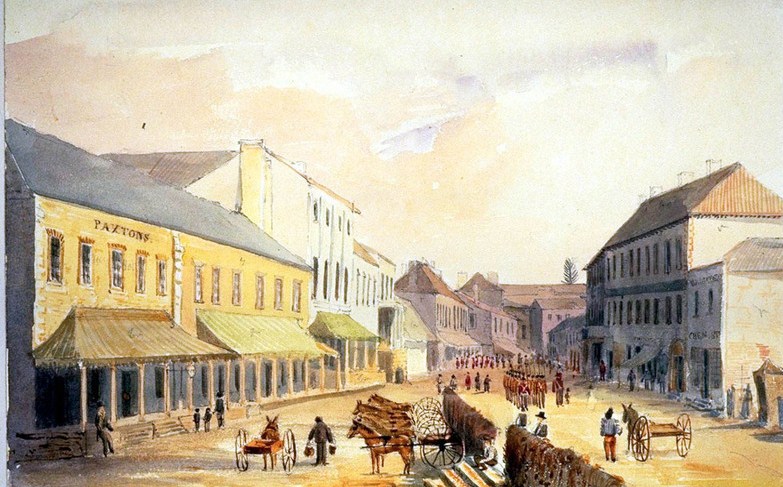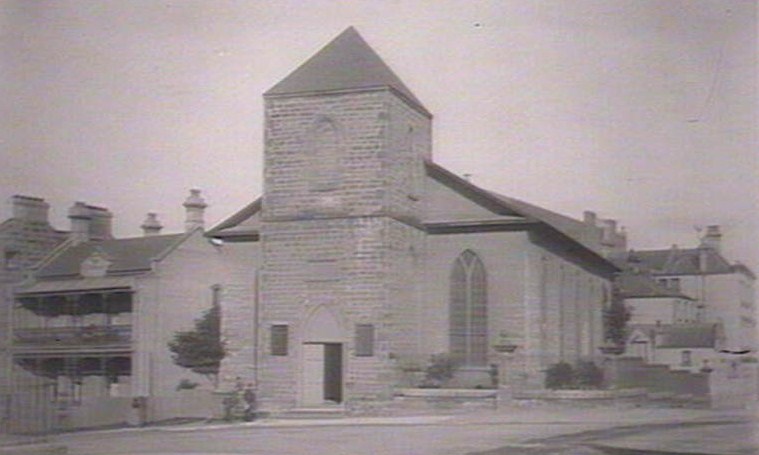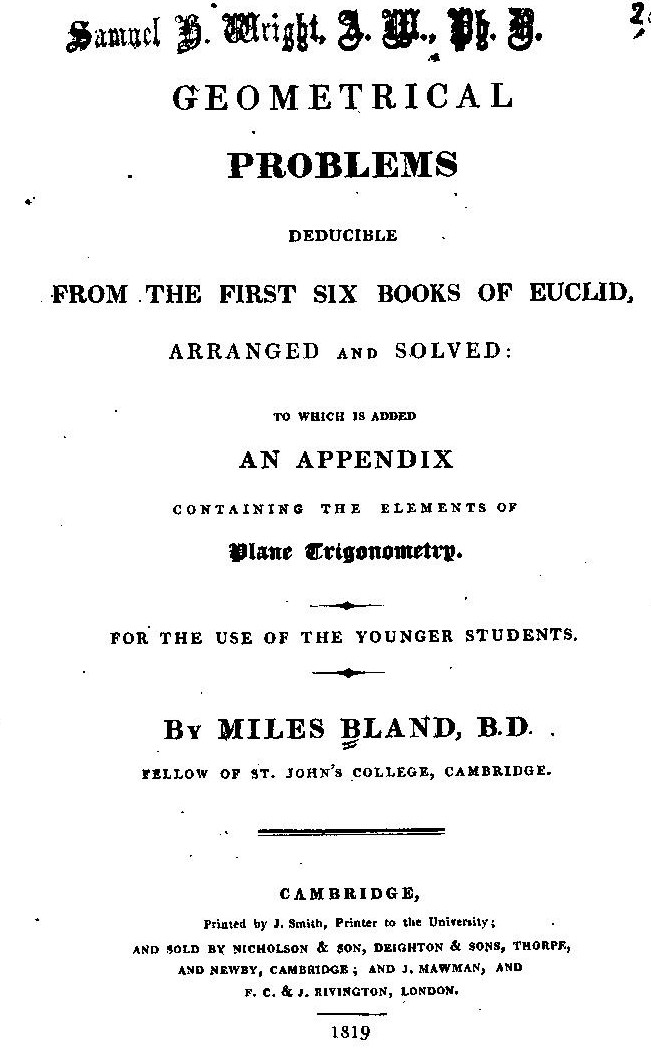The Australian College for boys was established in November 1831. It was one of the earliest collegiate schools in the colony to offer a comprehensive curriculum in post-elementary school subjects, although Rev. Henry Fulton’s Academy had offered a limited classical curriculum in his private school at Castlereagh since 1816. Also the Sydney Free Public Grammar School, originally established by Dr Halloran in the 1820s as a private venture, may have taught some students at the junior post-elementary level. The Australian College was founded by Rev John Dunmore Lang as a distinctly Presbyterian foundation following an unsuccessful attempt to establish an elementary school, known as the Caledonian Academy in 1826. It had operated less than one year. Lang recruited staff from Scottish universities as teachers and The Australian College continued until 1841 when it closed for a period of five years, reopening in 1846 and continuing until its closure in 1854.
John Dunmore Lang’s concept of a colonial school

John Dunmore Lang, Presbyterian minister, fiery politician and founder of The Australian College. Watercolour, 1841. State Library of New South Wales P2-68
To suit the context of a rapidly expanding colony, Lang believed that a school, which he first described as an ‘Academical Institution’, should provide an education that was both practical and utilitarian rather than liberal or strictly classical. Lang’s biographer, Don Baker (1985) states that Lang believed that the proposals that the head of the Anglican church in New South Wales, Archdeacon Broughton, had advanced for a seven-year classical training were unsuitable. “In Australia, he [Lang] believed, education should prepare young men for the ordinary business of life which they had to undertake earlier than in the mother country.”
This approach to colonial education in Australia is reflected in the structure of the curriculum, which was subsequently outlined. It was Lang’s plan that the College would recruit pupils from both the middle and wealthier classes in the colony of New South Wales.
When Lang arrived in the colony in the 1820s, the colonial government had subsidised a number of small local and private schools in the settled areas of the colony. These included denominational (church) schools. Two post-elementary schools had been established, both private boarding schools, one being the school established by Rev. Henry Fulton in 1816 at Castlereagh, which, though small and catering initially for only 12 students, followed a typical grammar school curriculum. The other school was established in Sydney by Dr Halloran whose Free Grammar School failed after a few years. Lang feared that Archdeacon Broughton would proceed to establish an Anglican grammar school in the colony. Lang’s intention was to provide an essentially Presbyterian school that would cater for the educational needs of elementary school children, who could then proceed to a higher curriculum if their abilities so permitted; but essentially it was to be a Presbyterian school. Lang was fearful of an Anglican monopoly over post-elementary, including classical education in the colony, stemming from Broughton’s determination to establish an Anglican grammar school, later to be known as “The King’s School” at Parramatta. A parallel Kings’s School in Sydney failed.
Planning the college
To finance the building of the college, Lang, during his visit to London in 1830, approached the Secretary of State for the Colonies, Viscount Goderich, for a loan of 6000 pounds from the British Government. Lang would undertake the raising of an additional 4000 pounds towards the cost of the proposed College by inviting supporters of the college to purchase shares at 50 pounds each. The full text of the proposal to the British Government for the school’s establishment is published in the Historical Records of Australia. Details of Lang’s financial proposal to Goderich are stated in the Prospectus which includes the following statement:
To effect the establishment of an institution of the kind proposed, a capital of 10,000 Pounds would be requisite; but if 6000 Pounds of that sum could be raised in the first instance by way of a loan to commence the Institution, and to afford a nucleus around which the sober-minded Colonists could gather, the Writer of this Prospectus pledges himself to raise the other 4000 Pounds in the Colony by shares of 50 Pounds each and to take shares to the amount of 1000 Pounds for his own family. (Historical Records of Australia, 1923, vol.16)
In a despatch to Governor Darling (12 January 1830), Goderich indicated the support of the British Government for Lang’s proposed college. The Treasury would provide a loan of 3500 pounds to Lang towards the construction of the College, adding, “The proposed buildings to be erected on the ground belonging to the Scotch Church”. The issue of the land on which the College was built was to be a great problem for Lang within a few years of the College’s establishment.
Location and construction of the college

George Street Sydney in 1847. State Library of New South Wales, PXC281A.1
Construction of the college building commenced in October 1831 on what Lang then believed to be Presbyterian land in Jamison Street next to the Presbyterian Church. Baker states that on 15 November 1831, The Australian College began teaching in a near-by hired premises in George Street while the permanent college building was being constructed. Baker (1985) states: “Between 14,000 Pounds and 15,000 Pounds was spent on the whole project of the Australian College. This sum covered not only the building costs but also the expenses of buying books and equipment, the recruiting and fares of teachers, the hiring of temporary accommodation and other incidental items. If this total sum 3500 Pounds came from a government loan, about 1800 Pounds was subscribed by the public (there were a few donations in addition to the sale of shares) and Lang contributed 9000 Pounds.”
Details of the curriculum are contained in the Prospectus for the College which is included in the Historical Records of Australia. Under Lang’s leadership the local supporters of the college project met on 23 December 1831 and resolved that the management and governance of the college be vested in a council of thirteen members. Lang was formally appointed Principal of the College without salary and teaching duties.
Council of the college
- C.D. Riddell, Colonial Treasurer
- Hon. Richard Jones
- Hon. Alexander Berry
- Major Mitchell
- Captain Perry
- Thomas Barker
- Robert Campbell Jnr
- James Chisholm
- David Ramsey
- Thomas Walker
- Dr Lang (Secretary)
- John Wallace (Treasurer)
The chairman of the Council, Campbell Riddell, was NSW Colonial Treasurer and a lawyer. Richard Jones was a merchant and pastoralist, a Director of the Bank of Australia and President of the Gaslight Company and member of the Legislative Council of the colony. Alexander Berry was a landholder in the Shoalhaven district, a merchant and businessman. Sir Thomas Mitchell was Colonial Surveyor-General and member of the NSW Legislative Council. Samuel Perry, soldier and surveyor was Deputy Surveyor General. Thomas Barker was an engineer and manufacturer who became a Director of the Commercial Banking Company and later a Trustee of the Sydney Grammar School and benefactor of the University of Sydney. Robert Campbell Jr. was a merchant, whose uncle, Robert Campbell founded the Campbell Trading house in Sydney. James Chisholm was a Director of the Bank of New South Wales and was also a merchant. David Ramsey lived at Dobroyd, Sydney, while Thomas Walker was a merchant and banker, and later a Director of the Australian Steam Navigation Company. John Wallace was an officer in the Colonial Treasury. This was a significant group among the colonial governing and commercial elite.
Staffing the college

Scots Church in Jamison Street, Sydney. The Australian College was built close by. Date of photo, unknown. Building dates from 1820s. State Library of New South Wales, GPO1-08138
Lang was instrumental in securing highly qualified teachers for the College, initially most of them being university graduates and ordained Presbyterian clergymen. Lang was the foundation Principal of the College and his foundation senior teaching staff consisted of Rev. H. Carmichael MA, Head of the Classics Department. He had been a teacher in London at the time of recruitment by Lang. Also recruited were Rev W. Pinkerton, MA, Head of the English Department, who died in May 1834 aged only 34; Rev J. Anderson, Head of the Mercantile Department; and Rev J. McGarvie, Head of the Mathematical and Physical Department. McGarvie was to leave the College after a short time and take up duties in charge of the Presbyterian Church at Launceston. Carmichael, one of the most learned and successful teachers fell out with Lang and left the Australian College in 1835 to set up his own private “Normal School”.
Carmichael and Pinkerton were replaced by Rev Robert Wylde, from the University of Glasgow and Rev David Mackenzie from the University of Edinburgh. Tutors, or junior teachers were appointed to assist in the teaching of the various classes. Senior members of staff had their passages from Scotland and England paid by the College and were appointed on a salary of 100 pounds per annum with accommodation provided. By 1838 additional staff were recruited to teach the increasing numbers of students. John McLure, previously from King’s College Aberdeen, was appointed as an Assistant Master; Rev Aitken from Glasgow University was appointed a head of department; a Mr Smith was appointed the French Master and Mr Elyard the Drawing Master.
The curriculum
According to the First Report of the Council of the Australian College in 1832 there were 50 pupils enrolled in the College of whom 20 attended Latin and Greek classes. Arithmetic was compulsory for all pupils. Rev McGarvie taught Natural Philosophy and Chemistry and also gave lectures on political economy. Assistant masters were later appointed to teach writing, arithmetic, book-keeping, geography, and drawing. Thus the curriculum was, in part, a classical grammar school program for those pupils at the post-elementary level, though it is significant to note, from the list following, the presence of commercial or technical subjects in the curriculum at both levels.
In 1835 according to the Report of the College, the curriculum including the following:
- Ancient and Modern History including Greek and Roman History
- Geography
- Mapping
- French
- Letter Writing
- Mathematics
- English Composition
- English Grammar
- Penmanship
- Euclid
- Natural Philosophy
- French
- Latin and Greek
- Scripture
The College enrolled students at both the elementary and post-elementary levels. The majority of foundation students were children at the elementary level. As was usually the case in this period, English (commercially useful subjects) needed to be offered as well as the classical languages.
Pupils enrolled in The Australian College during the foundation years
Lists containing the names of pupils known to have been enrolled in the Australian College during its early years follow. The First Annual Report states that there were 50 pupils enrolled in the elementary grades.
1835: Frederick Despard, Walter McPherson, Phillip McPherson, Charles MacDonald, James White, William Crocker, Henry McVitie, George Bowman, John Chisholm, Alexander Chisholm.
1837: James White, R.G. McDonald, Alexander Chisholm, Thomas Barker, J. Bowman, George Cadell, Edward Simpson, John Macleod, James Stewart, Thomas McVitie, George Bowman , Peter McPherson, George Pike, Durham Nicholson, William Piper, Angus McKay, G.H. Barney, John Gardner, William Rankin, John Atkinson, Robert Campbell.
The Scottish ancestry of most pupils is easily discerned by their names. It may also be noted from the lists that some of the names indicate that children of a number of Sydney’s merchants and government officials were enrolled in the College. James Cameron, in his Centenary History of the Presbyterian Church in New South Wales says, “for some ten or twelve years the College did good work; over 500 young men received a thoroughly sound education there, and several who afterwards became prominent colonists received their education within its walls. Among these we may mention the late Hon. John Robertson, the Hon. Sir George Dibbs, Mr T. A. Dibbs, John C. Dibbs, Thomas B. Gaden, W.H. Gaden and brothers George, John and William Bowman and the Howes of Glenleigh.”
The college in 1839
J. D. Lang, in his Reminiscences of My Life and Times (1972), reproduces Judge William Burton’s comments on The Australian College following his visits in 1838 and 1839. These were originally published in Burton’s The State of Religion and Education in New South Wales (1840).
Having visited the Australian College at the commencement of the years 1838 and 1839, the writer of these observations was highly impressed in favour of the course of instruction pursued in so far as it had proceeded. Questions were proposed on all the subjects of instruction, and answered with a quickness that proved both the knowledge and care of the teachers and the aptness of the scholars. Quickness and sprightliness were indeed the general characteristics of the latter; but some evinced also a depth of reflection evidently proceeding from solid genius.
The number of the students in the College during the year 1838 was 116; of this number 32 attended the Latin and Greek classes. In the Natural Philosophy classes, lectures illustrated by experiments are delivered, and subjects prescribed on which the students wrote, by way of exercise. Of these essays (some of which extended to sixty closely written pages) several hundreds were given in during the year and several were read with much gratification by the writer of these observations, as showing, in many instances, acuteness of observation and reflection particularly interesting and useful as indicators of the natural bent of the mind of the pupils, each being at liberty, about a number of subjects proposed, to write upon that which he chose.

One of The Australian College’s textbooks, the 1819 edition of Bland’s geometry.
In the mathematics classes, Euclid’s elements and Bland’s geometrical problems were used as text-books. In the course of the year about 46 attended the classes for Natural Philosophy and Mathematics. About 70 attended the classes for History and Geography.
The library of The Australian College
One of the most significant aspects of the early history of the Australian College was its library, established soon after foundation. From the evidence of the published lists of books acquired by the Library at different stages, largely by donation, it is likely that the library in the 1830s and 1840s would have been one of the largest and most comprehensive libraries in Australia at that time. It may well have been the first Australian school library of any significance. Given that Lang himself purchased 1700 books for the library while visiting England, plus those books listed which were acquired by donation, together with the Joseph Hume donation of 282 books listed in the Colonist newspaper, the Library might possibly have contained well over 2000 books, a very large collection for a school library at that time.
It appears from Lang’s published account of his journey to England in 1830 to secure finance, staff and equipment for the proposed college, that from it beginnings the institution was most fortunate in obtaining funding and donations of books and scientific apparatus for the college library. Lang’s account is contained in his An Account of the Steps Taken in England with a view to the establishment of an Academical Institution, or College, in New South Wales and to demonstrate the practicability of effecting an extensive Emigration of the Industrious Classes from the Mother Country to that Colony. This report of his achievements was published in Sydney in 1831 upon Lang’s return, accompanied by a large group of emigrant mechanics in addition to teachers for the college.
Closure of The Australian College
The College was closed from 1841 to 1846 owing to what appears to have been a number of factors, including declining enrolments and the subsequent loss of staff. An economic recession and the associated financial difficulties of numerous parents supporting the college may explain the decline in enrolments. Another factor may have been that one of the two remaining College staff, Lang himself, was in England in 1841 where he was attempting to resolve his financial problems.
The college re-opened in 1846 and struggled on for another eight years until it was finally closed in 1854, again largely because of its declining enrolments and competition from other schools in the colony. However Baker suggests another possible contributing factor to the school’s demise: “By 1850, the property having become too valuable, he [Lang] felt to be used as a College, he hoped to secure an Act of the Legislative Council to enable the Trustees to sell the Australian College and use the proceeds to erect more suitable buildings on a cheaper site, probably in connection with the recently established University of Sydney.”
During its twenty three years of operation The Australian College made a significant contribution to elementary and secondary education in the colony. At that time, New South Wales was changing from a penal colony to one which was based increasingly on the immigration of free settlers, the development of commerce and rural expansion. The college was an early indication of the great significance that Scottish traditions in education and schooling would have in Australia.
